Horseback safari in a reserve on the edge of the Kalahari in Namibia.
- An ideal safari to discover a horseback safari
- Accommodation in a comfortable lodge with swimming pool
- 1 night in a bush camp by moonlight and stars
Horseback safari in Namibia, ideal to discover an equestrian safari. Gallop through the savannah and observe the wildlife of Namibia on horseback. Discover this superb environment, not only on horseback, but also on foot in the bushman, or by car. The reserve is a family reserve on the edge of the Kalahari, of 10,500 hectares, with its comfortable lodge. It is home to the endangered black rhino, as well as a variety of plains game such as springbok, giraffe, oryx, impala, kudu, eland, wildebeest... And much more. Ride red sand trails on horseback through savannah landscapes, cross bushes and salt marshes. Participate in conservation and anti-poaching efforts in the reserve which contribute to the survival of the black rhino. You enjoy gallops at sunset through the savannah, ending each evening with an aperitif at different places in the reserve. You camp for a night under the stars, and enjoy one of the most beautiful skies in the world. You go in search of rhinos during safaris in the bushman, and discover: the plants, animals and the Kalahari ecosystem. You stay in one of the comfortable rooms of an old farmhouse converted into a lodge, which has a swimming pool and a sauna. You dine in the traditional space overlooking a waterhole, followed by evenings around the fire, exchanging stories with other riders from all over the world, who share the same passion for horse riding and Africa.
HORSEBACK SAFARIS
SEE ALL OUR OFFER: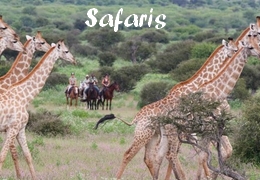

EQUESTRIAN SAFARI
IN NAMIBIA AT THE EDGE OF THE KALAHARI
INDICATIVE ITINERARY *
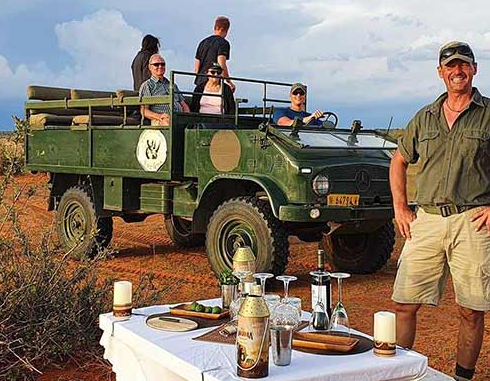
Day 1 - Arrival at Windhoek airport and transfer to Kuzikus reserve (approximately 2 1/2 hours). Lunch. Relaxation after your trip in the afternoon. Tea and cakes, meeting with your guide. Open-air vehicle safari and aperitif. Dinner.
Day 2 - Breakfast. You get to know your horse during a first easy ride. Lunch. Relax by the pool or watch the animals at the waterhole until tea time. Sunset horseback ride through the savannah to the salt marshes, where you unsaddle and let the horses graze for the night while you enjoy a sunset aperitif. Dinner.
 Day 3 - You start the day early in the morning, and go in search of black rhinos, discover more about rhinos and the conservation projects of the reserve. Breakfast. Relax until lunch or tea. Sunset ride through the savannah and bush, to the territory of the black rhino, and finish with an aperitif. Dinner.
Day 3 - You start the day early in the morning, and go in search of black rhinos, discover more about rhinos and the conservation projects of the reserve. Breakfast. Relax until lunch or tea. Sunset ride through the savannah and bush, to the territory of the black rhino, and finish with an aperitif. Dinner.
Day 4 - Breakfast. Bush Trip: Learn how bushmen hunt animals and survive in the Kalahari. Lunch. Relax. Sunset ride and aperitif. Dinner.
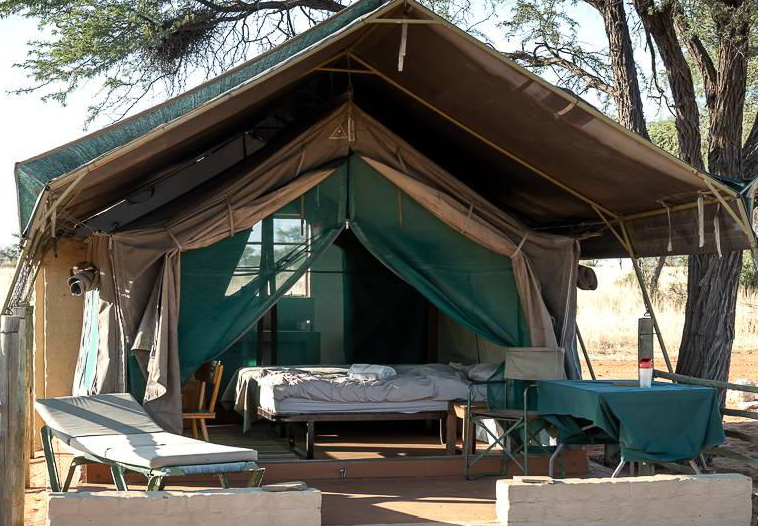 Day 5 - Breakfast. “Morning Patrol Ride”: Help keep black rhinos safe. Lunch. You return to camp for the night, and enjoy a dinner prepared on the fire.
Day 5 - Breakfast. “Morning Patrol Ride”: Help keep black rhinos safe. Lunch. You return to camp for the night, and enjoy a dinner prepared on the fire.
Day 6 - Breakfast. Hike, return to the lodge and discover plants and animals along the way. Lunch. Horseback ride at sunset towards the dune. Dinner.
Day 7 - Breakfast. You have a morning with nothing planned: you can relax or choose to add another activity that the lodge offers (not included in the price). Lunch. Meet for your farewell aperitif. Dinner.
Day 8 - Breakfast. Transfer to Windhoek airport.
* Indicative itinerary which can be modified if necessary.
MEETING:
Day 1: at Windhoek airport. Free transfer to the lodge.
DEPARTURE:
Day 8: free transfer to Windhoek Airport after the breakfast.
FLIGHTS:
Flights to Namibia are not included in our prices because it is generally more interesting to book your flights yourself; a flight-inclusive package is generally more expensive with agency commissions. However, we are at your disposal to help you find the best prices or offer you a transport trip included on request.
RIDING LEVEL: ![]()
These safari is for advanced riders. Riders should be comfortable spending up to 3 hours straight in the saddle and at all paces. Riders should be able to rise in the trot and canter. Horses are schooled English-style and are used to contact in the trot and canter.
RYTHM:
You ride about 3 hours a day on horseback.
GROUPS:
Maximum 10 riders.
AGE:
Minimum 12 years old.
GUIDE & TEAM:
Local guide + English speaking support staff. HORSES:
HORSES:
Appaloosas, thoroughbreds, Arabian crosses. The horses spend the night in the reserve and are very used to interacting with wildlife.
TACK:
English tack (general purpose, dressage, or English treeless saddles).
ACCOMMODATION: ![]()
In a small, intimate lodge with only 7 large, comfortable and sunny rooms with en-suite bathrooms and your own veranda. There is also a beautiful semi-shaded swimming pool, a sauna for cold winter days, an extensive library, an information center, and a dining area overlooking a scenic water hole. One night in an outdoor camp.
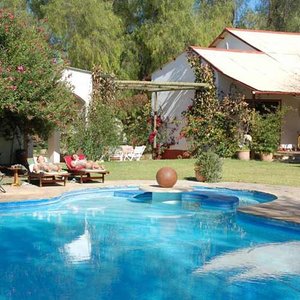
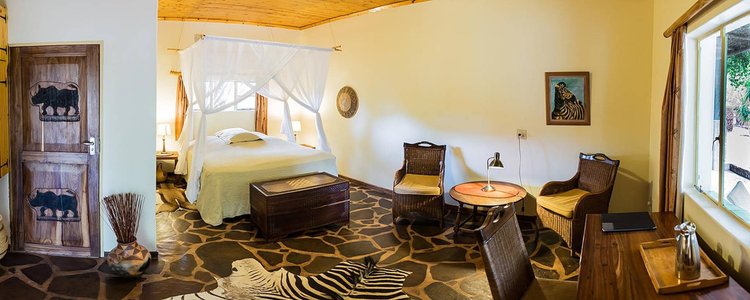

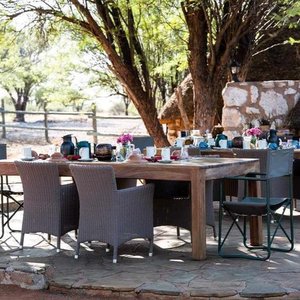 MEALS:
MEALS:
Enjoy a European-style nutritious breakfast with bread, cold meat, eggs, cereals, fruit salad, good coffee and a selection of teas. Morning tea and coffee will be served directly to your room. A delicious warm lunch will be served together with a salad after your morning’s excursions. In the evenings an elegant 3-course dinner frequently featuring game meat, served in the spacious, straw-thatched Lapa in “old Africa style”. In addition there will be coffee, tea, and homemade cake in the afternoons. Most of the products are freshly sourced from the region, integrating local farmers into their conservation framework. Of course the chef is also happy to cater for any special dietary wishes. Additionally there is a large selection of soft drinks & alcoholic beverages, an excellent wine assortment as well as Champagne and sparkling wines.
2025 PRICES / PER PERSON *:
2390 € in 2 person shared bedroom/tent
Single bedroom/tent supplement: 60 €
Booking fees: 15 €
* Prices may be revised down or up depending on the exchange rate.
PRICES INCLUDE:
Horse and tack rental, local guides, accommodation, meals, transfers from/to Windhoek airport, the financial guarantee of your payments by our deposit of travel operator.
PRICES DON'T INCLUDE:
Individual insurance, personal expenses, tips, alcoholic beverages (wine and aperitifs) and sodas, flights to/from Windhoek, anything not indicated in "the price includes".
INSURANCE:
A civil liability and travel insurance (assistance/repatriation) is compulsory. A cancellation insurance is strongly recommended.
A payment by credit card can make you benefit from its possible insurance (check your contract).
We offer to Europe Union, Switzerland, Liechtenstein, Norway residents: the Chapka insurances.
Cap Security: full insurance with cancellation. Cap Cancellation: cancellation only.
See prices & information
FLIGHTS:
Flights to/from Johannesburg are not included because it is more interesting to book directly your ticket: a transport package included is generally more expensive with agency commissions. However, we are at your disposal to help you find the best prices.
CLIMATE:
Month | Jan | Feb | Mar | Apr | May | Jun | Jul | Aug | Sep | Oct | Nov | Dec |
Average High Temperature (°F) | 84 | 84 | 82 | 79 | 75 | 70 | 70 | 75 | 80 | 82 | 83 | 84 |
Average Low Temperature (°F) | 63 | 62 | 60 | 54 | 47 | 41 | 41 | 45 | 51 | 56 | 59 | 62 |
Average High Temperature (°C) | 29 | 29 | 28 | 26 | 24 | 21 | 21 | 24 | 27 | 28 | 28 | 29 |
Average Low Temperature (°C) | 17 | 17 | 16 | 12 | 8 | 5 | 5 | 7 | 11 | 13 | 15 | 17 |
Average Precipitation (days of rain) | 10 | 8 | 8 | 6 | 1 | 0 | 0 | 0 | 1 | 6 | 10 | 11 |
SEASONS:
The climate over most of Southern Africa is temperate. Hot, dry conditions are usually encountered in the Tuli region. Heavy summer thunderstorms of short duration in the late afternoon and evening may be experienced. Rainfall occurs mostly during the summer months (October - March).
Summer (December to February):
The temperatures are high and there is a lot of humidity in the air. The chances of convectional thunderstorms are great. Some of the summer migrant birds begin to arrive. The characteristic call of the Red-chested Cuckoo rings out clearly, heralding the approach of better times for all. Once good rains have fallen, the small, drab, but extremely vocal Monotonous Lark keeps the bush awake day and night with its irritating call, as they perch on every treetop.
Kudus calve and there is a good chance of seeing late Impala lambs, tottering along on spindly, wobbling legs behind their mothers. Due to the heat, the animals wisely begin to seek shade before 8 o’clock in the morning, only becoming active again in the late afternoon, just prior to sunset. Tropical thunderstorms are a regular afternoon feature and there is a high probability of flooded rivers to add some excitement to game drives.
Autumn (March to May):
The transition from summer to winter occurs rapidly in the Limpopo Valley. Finally the searing heat of summer begins to abate and there is less likelihood of rain. This is a truly splendid time of the year. It is now Autumn and the daily temperatures are most pleasant with balmy days and nights. Temperatures begin to drop rapidly after sunset and both evening and morning game drives require warmer clothing. Although chilly in the morning, the days are clear and pleasant with crisp blue skies. Now that the rains are over, the veldt begins to dry out and game begins to congregate around the major watercourses, such as the Limpopo and associated wetlands, as well as the artificial waterholes scattered throughout the reserve.
A few late Kudu calves may make a bemused appearance in the beginning of March. Large nursery herds of gawky Impala young are found, kept under some control by the watchful eyes of their mothers.
The bush is still dense, but the bright shades of green are starting to become duller as the year progresses. As the vegetation begins to thin, the elusive leopard is more frequently seen. Lions, which dispersed with the game during the wet season, now begin to concentrate their activities in the central area of Mashatu.
Winter (June to August):
Winter is now upon us and has spread its chilly grip on Mashatu. The days are still good, with crisp mornings. The nights can be very cold.
Most of the natural pans and pools have now completely dried up. Elephant and a host of other species begin to frequent the artificial waterholes at both Main and Tent Camps, which makes for exciting mealtime viewing. Predator sightings are good at this time of the year, due to the thinned out vegetation and concentrations of game, cheetah however are scarce. In general the game is more active later into the day.
This is also a favorable time to visit the archaeological site at the Motloutse River. The summer vegetation has disappeared and a host of interesting features are now visible.
Towards the end of winter, the floodplains and grasslands adjacent to the Limpopo are very dry and barren. The bush has become harsh and almost inhospitable, with absolutely no groundcover, only dust and rocks visible for kilometers. The veldt has all the typical winter hues of brown and red, as the Mopane leaves start turning. The weather is fine with temperatures increasing slightly. The early mornings and evenings being not as cold as in June or July. August is a showy month, with respect to sunsets. Due to the very dry conditions, large quantities of dust is taken up into the air, giving rise to spectacular pyrotechnic displays as the sun sinks below the horizon.
Spring (September to November):
The bush is still very dry, a condition exacerbated by winds, which blow from August through to October. Temperatures begin to steadily increase and conditions are becoming desperate for many of the herbivores. This is due to sub region frontal systems touching on the Limpopo Valley, bringing superheated air into the region. There may be an occasional tropical thunderstorm, but this early rain is sucked up like a sponge by the barren earth. This welcome water is however not enough, and seldom results in a notable floral display. Many trees begin to blossom, in anticipation of the rapidly approaching summer. The vibrant hues of the blossoms enliven the bush, providing a bountiful treat for baboons and other hungry inhabitants of the bush, all of whom have struggled through the lean winter months. Temperatures begin to creep upwards and game drives are once again early morning and late afternoon affairs, as a wise means of avoiding the debilitating midday heat.
Predators have a field day, as many of the game are weak and tend to restrict their activities to the area close to the waterholes. The lack of dense vegetation and the dry powdery soil make tracking lion and leopard an easier task and often result in exceptional sightings. Elephant listlessly wait out the dry season, moving from waterhole to waterhole, where they take full advantage, wallowing and drinking for hours. They will feed on the surrounding vegetation, moving into the bush on feeding forays when temperatures have dropped sufficiently for them to forage out of the protective shade. It is also at this time that eland begin to calve.

